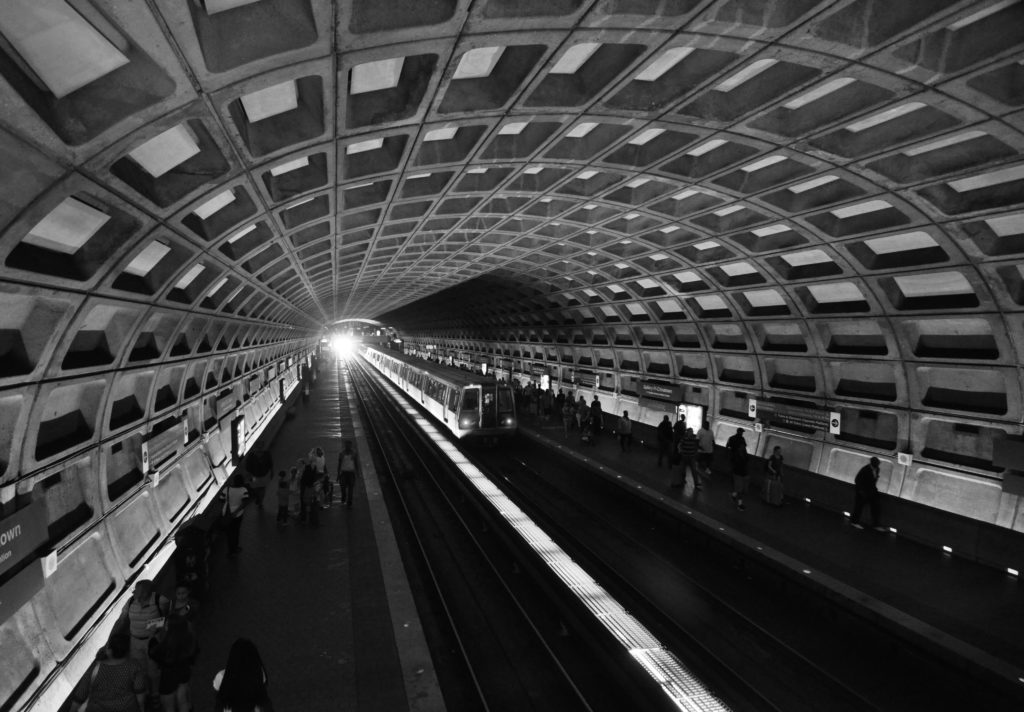
In a recent post on Curbed, architecture critic Alexandra Lange dove into the history of the Washington, D.C. Metro (a.k.a. WMATA), finding that its designers envisioned a forward-looking transit system with longstanding appeal. Metro architect Harry Weese and his firm traveled the world studying existing transportation examples, noting details down to the fabric selection of ticket collectors’ uniforms, before returning stateside to design what has become one of D.C.’s most recognizable landmarks. The D.C. Metro system has been celebrated since its 1976 opening for its column-free, Brutalist vaults of concrete, and was the recipient of the AIA 25-Year Award for Architecture in 2014. This spring, D.C. Metro became the focus of controversy discussed elsewhere and on these pages for (in addition to longstanding issues of management, safety, and scheduling) an ill-advised whitewashing of the vaults at its Union Station stop.
Here’s Lisbon. There’s nothing like a drawing for flavor. pic.twitter.com/ECxY419dLp
— Alexandra Lange (@LangeAlexandra) July 5, 2017
One resource Lange studied was a self-published book with a cumbersome title–”For the Glory of Washington: A Chronicle of Events Leading to the Creation of the System-Wide Architectural Concept for the Design of the Washington Metro Stations, December 1965 – November 1967″–by Stanley Allen, who was chairman of Harry Weese Associates at the time. This book chronicles the firm’s deep involvement in the systemwide design of the D.C. Metro system. Lange sifts through accounts of a worldwide subway tour to preliminary sketches to CFA hearings, and links her findings to current stances on infrastructural maintenance across the country:
To honor the people who clean, upgrade, and augment, we have to see transit design as Weese did: distributed across the city, both as a network of connected stations, platforms, and trains, and as a network of connected tasks. Weese and his team identified the problem, but needed the sometimes harsh design critiques of the Commission of Fine Arts (CFA), “the only federal commission dedicated to design review and aesthetic excellence,” as it says on its website, to create a solution that spoke to place, operations and maintenance.
Maintenance has long plagued the D.C. Metro system. In response to outcry from the architectural community and preservationists over the Union Station paint job, some Metro riders voiced approval for the painting, citing the need for brighter conditions. But underground white paint can only reflect the light that shines on it, besides which, it is a temporary solution–a $100,000 bandage that will need to be re-applied continuously–when upgrades to William Lam’s lighting design, if budget allowed them, would provide a more permanent fix. Again, Lange:
If WMATA had consulted with the CFA or historians, they might have learned that the concrete, if cleaned, with the lighting maintained as Lam intended, would solve the very brightness problems the paint (three coats, easily soiled) provided a short-term solution for. … The paint offers a momentary ‘Ah!’ but the money would be better spent on soap and replacing the lightbulbs with new LEDs—work less likely to be noticed because it’s maintenance.
The purists among supporters of Brutalism note that the style’s moniker stems from béton brut–or, raw concrete–meaning that the paint not only issues a long-term repainting sentence that WMATA seems incapable of serving, but also detracts from the architectural and stylistic integrity of the D.C. Metro.
Former Washington Post architecture critic Benjamin Forgey raised a similar outcry in 1992 over the repainting of the Farragut North Metro station, comparing the D.C. Metro’s 600-foot-long, public great halls to classical architecture:
Like much of the city’s above-ground architecture–the barrel vaults in, say, John Russel Pope’s National Gallery West Building or Daniel Burnham’s Union Station–it is based upon classical precedents. But in its forthright expression of structure in those bold concrete vaults, it’s also modern–a shadowy, richly textured space of our own time. There’s no mistaking that the color and texture of the concrete contribute greatly to the architectural effect.
Perhaps Forgey gets to the point quicker: Paint applied to the vaults flattens out the texture for which the D.C. Metro stations and other Brutalist buildings are celebrated, and you don’t solve problems (of lighting, concrete deterioration, or any others) by painting over them.
